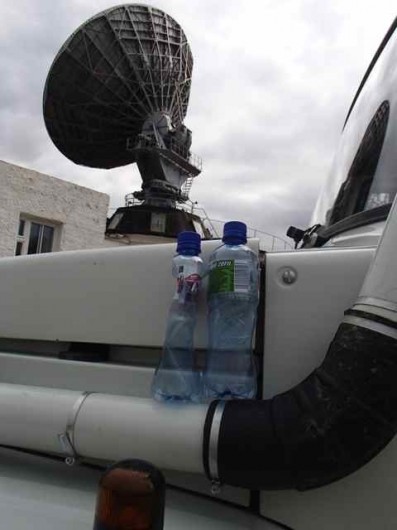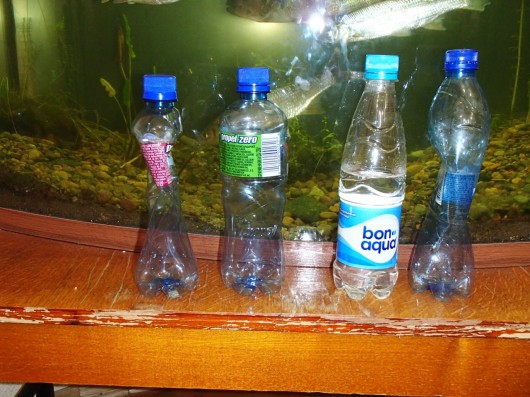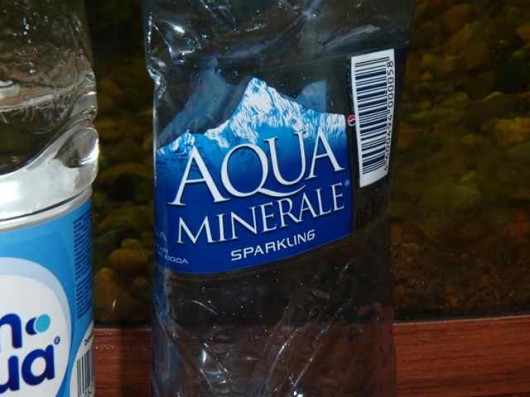(This post is by Mark Paricio, a PolarTREC teacher accompanying the Polaris Project this year.
To read all of Mark’s posts, go to: http://www.polartrec.com/expeditions/siberian-arctic-systems-study )
So what happens if you fill a plastic bottle with air on the 14,265-foot summit of a Colorado mountain and bring it down to sea level in Cherskiy, Siberia? This is the experiment proposed by my students in Colorado that I wrote about in my June 19th journal on the PolarTREC site above.
The Results are In!
I packed two bottles filled with air inside my boots during my trip. One was the bottle I filled on top of Mount Evans in Colorado. The other was a bottle of the same type that I brought along simply for comparison purposes. Below, is a picture comparing both bottles outside the Orbita building of the Northeast Science Station.

A comparison of the air from Colorado water bottles in front of Orbita. The bottle on the left was filled with air at 14,265 feet above sea level. The bottle on the right was filled with air in Cherskiy, which is only a few meters above sea level.
Not only is the bottle collected at 14,265 feet much thinner, it has also lost volume by compressing downward.
Why Did This Happen?
The atmosphere is essentially a fluid – that is it flows. As a fluid, atmospheric gasses settle into low areas and thus there is a higher concentration of air molecules at lower altitudes, like sea level, than there is at higher altitudes as on the top of a mountain.
Air pressure is the result of the collisions of these moving air molecules with objects. In the compressed bottle, there simply aren’t enough gas molecules inside the bottle to push the bottle outward against the larger number of collisions from the greater density of the outside air molecules. Thus, the outside molecules push harder and compress the bottle until the inside molecules are pushed into a small enough volume that they can exert the same amount of pressure outward by colliding with the walls of the bottle more often.
In the uncompressed bottle on the right which was filled with air in Cherskiy, there are already enough air molecules on the inside to balance the collisions from the molecules on the outside of the bottle.
An Accidental Experiment on the Trip to Cherskiy
As I was flying the last leg of my trip to Cherskiy, I drank a water bottle that I purchased in Yakutsk. The airplane I was on flew at about 20,000 feet above sea level. When I finished my water bottle in the middle of the flight, I sealed it and tucked it into my backpack.
By the time we landed in Cherskiy, my Russian water bottle had compressed almost as much as the one from the top of the Colorado mountain. Examine the bottle on the far right in the picture below and compare how much it has compressed relative to a similar sized bottle to its left.

A comparison of all my water bottles in front of the new aquarium inside Orbita. The bottle on the far right was sealed during my airplane flight from Yakutsk to Cherskiy in Russia.
As airplane passengers would have a difficult time breathing at 20,000 feet of altitude due to the very low density of the air, airplanes are typically pressurized to be similar in air density to about 8000-feet above sea level. This becomes even more important for large jets that fly much higher than 20,000 feet.
Another Colorado Connection to my Russian Water Bottle
As I examined how my Russian water bottle compressed, I noticed that the mountain on its label seemed very familiar to me. If you are from Colorado, it might look familiar to you as well. Check out the picture below:
The mountain depicted on the front of the Russian water bottle is none other than a winter picture of 14,017-foot tall Wilson Peak, near Telluride, Colorado, that my beautiful wife, Cheryl, and I climbed together years ago. If you don’t believe me, search for its image on the internet!
It’s a small world!
Stay curious my friends! – Mark Paricio




